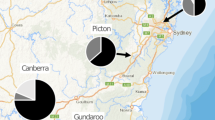Summary
In primitively eusocial wasps workers often retain the ability to become queens, so their continued performance in the worker role is partly dependent on elevated genetic relatedness between workers and the brood they rear. In colonies of the social wasp,Mischocyttarus mexicanus, workers were related to female pupae by 0.29±0.12, a value that is significantly below the full sister value of 0.75, but not significantly below 0.50, worker relatedness to daughters. Though individuals often build new nests within meters of their natal nest, there was no genetic population structure discernable among four nest clusters, or inbreeding of any kind.
Similar content being viewed by others
References
Goodnight, K. F. and D. C. Queller, 1994.Relatedness 4.2b. Goodnight Software.
Litte, M., 1976. Self, kin and social behavior in the polistine wasp,Mischocyttarus mexicanus. PhD. Dissertation, Ithaca, N.Y.; Cornell University.
Litte, M., 1977. Behavioral ecology of the social wasp,Mischocyttarus mexicanus.Behav. Ecol. Sociobiol. 2:229–246.
Peters, J. M., D. C. Queller, J. E. Strassmann and C. R. Solls, 1995. Maternity assignment and queen replacement in a social wasp.Proc. Roy. Soc. Lond. B 260:7–12.
Queller, D. C. and Goodnight, K. F. 1989. Estimating relatedness using genetic markers.Evolution. 1989 43:258–275.
Queller, D. C., J. E. Strassmann and C. R. Hughes, 1992. Genetic relatedness and population structure in primitively eusocial wasps in the genusMischocyttarus (Hymenoptera: Vespidae).J. Hymenoptera Research. 1:81–89.
Strassmann, J. E., 1981. Evolutionary implications of early male and satellite nest production inPolistes exclamans colony cycles.Behav. Ecol. Sociobiol. 8:55–64.
Strassmann, J. E., C. R. Hughes, D. C. Queller, S. Turillazzi, R. Cervo, S. K. Davis and K. F. Goodnight, 1989. Genetic relatedness in primitively eusocial wasps.Nature 342:268–270.
Strassmann, J. E., D. C. Queller, C. R. Solís and C. R. Hughes, 1991. Relatedness and queen number in the neotropical wasp,Parachartergus colobopterus.Animal Behaviour 42:461–470.
Author information
Authors and Affiliations
Rights and permissions
About this article
Cite this article
Strassmann, J.E., Queller, D.C. & Solís, C.R. Genetic relatedness and population structure in the social wasp,Mischocyttarus mexicanus (Hymenoptera: Vespidae). Ins. Soc 42, 379–383 (1995). https://doi.org/10.1007/BF01242166
Received:
Revised:
Accepted:
Issue Date:
DOI: https://doi.org/10.1007/BF01242166




